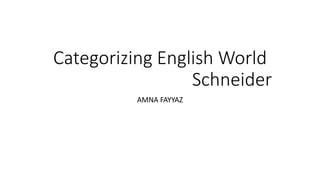
Categorizing English world
- 2. • Some scholars use “new varieties of English,” or also “indigenized” or “extraterritorial” varieties, and will also use some such paraphrases, including the terms dialect and variety, for stylistic purposes. The following three terms, however, have more precise implications: • World Englishes” is the most encompassing of all, denoting all or any of the varieties spoken around the world, including British English, and, of course, forms such as Nigerian, Malaysian, or New Zealand English. When using this term the perspective is usually a national one; regional dialects would probably qualify only indirectly. . The term goes back to ……….
- 3. •Braj Kachru On an international level counts as the following father of this discipline (Three circle’s Model, and the special importance of the Outer Circle). With the recent growth of the discipline, however, it has emerged as the most neutral and most widely used term.
- 4. New Englishes and Postclonial Englishes • “New Englishes,” coined by Platt, Weber, and Ho (1984), is explicitly restricted to the newly grown second-language varieties especially of Africa and Asia, like Tanzanian or Indian English. • “Postcolonial Englishes,” used predominantly in Schneider (2007), unites all the varieties which have shared origins in (mostly) British colonization activities, emphasizing this historical origin and the processes which have resulted from it. So it excludes British English but includes American or Australian English, the “New Englishes,” and Englishrelated creoles.
- 5. Several classification schemes have been proposed.. The first one categorizes countries in which English is spoken into three types: “English as a Native Language” (ENL), in which the language is spoken and handed down as the mother tongue of the majority of the population (as in the UK, the USA). “English as a Second Language” (ESL), in which English has been strongly rooted for historical reasons and assumes important internal functions “English as a Foreign Language” (EFL), in which English is widely taught in the education system, and people strive to acquire it for its international usefulness, but it does not really have any internal functions
- 7. • In 1980s Braj Kachru developed his “Three Circles” model.
- 8. • . The ENL/ESL/EFL scheme may be conceptually clear-cut, but it is probably a bit dry and unappealing. Kachru’s line of thinking adds a sociopolitical and developmental component (note that being “in” or “out” aren’t just neutral terms, and “expanding” implies a process of growth!), and a whole new agenda for research and generating awareness of issues. Kachru and his followers challenge the implicit predominance of the Inner Circle and emphasize the independence and practical importance of the Outer Circle (and also the Expanding Circle). They argue that English belongs to all those who use it (so there is no need to slavishly strive for a British model of usage and pronunciation), and view the Outer Circle countries as developing norms of their own. This model has thus instilled increasing self- confidence in localized varieties of English and strongly influenced language teaching and applied linguistics in countries of Asia and Africa in particular.
- 9. • Nevertheless, both of these classification schemes are also a bit problematic in that they abstract from complex realities, and perhaps both may be a bit dated by now and fail to reflect the vigorous spread of English and changes of its status in many regions over the last few decades. • A more recent approach which attempts to take such processes into consideration is the “Dynamic Model” of the evolution of Postcolonial Englishes, proposed by Schneider (2003, 2007a)
- 10. The model assumes five developmental stages, and on each of them a unilateral implication of four social and linguistic sets of conditions:
- 11. • “Foundation”: English is brought to a new territory, which leads to incipient bilingualism, the borrowing of toponyms, and other minor processes. • * “Exonormative stabilization”: during a stable colonial situation, the politically dominant “mother country” determines the norms of linguistic behavior, and elite bilingualism spreads amongst some representatives of the indigenous population, with lexical borrowing continuing. • * “Nativization” is the most vibrant and interesting of all the phases. With ties with the settlers’ country of origin weakening, and interethnic contacts increasing, bilingual speakers forge a new variety of English, shaped strongly by phonological and structural transfer – though conservative speakers resent such innovative usage.
- 12. • “Endonormative stabilization” implies that, after independence and inspired by the need for nation-building, a new linguistic norm is increasingly recognized (and commonly perceived as remarkably homogeneous), is beginning to be codified and to be accepted in society, and is employed culturally in literary representations. • * “Differentiation” may follow in the end, i.e. in a stable young nation, internal social group identities become more important and get reflected in the growth of dialectal differences.
- 13. Conclusion
